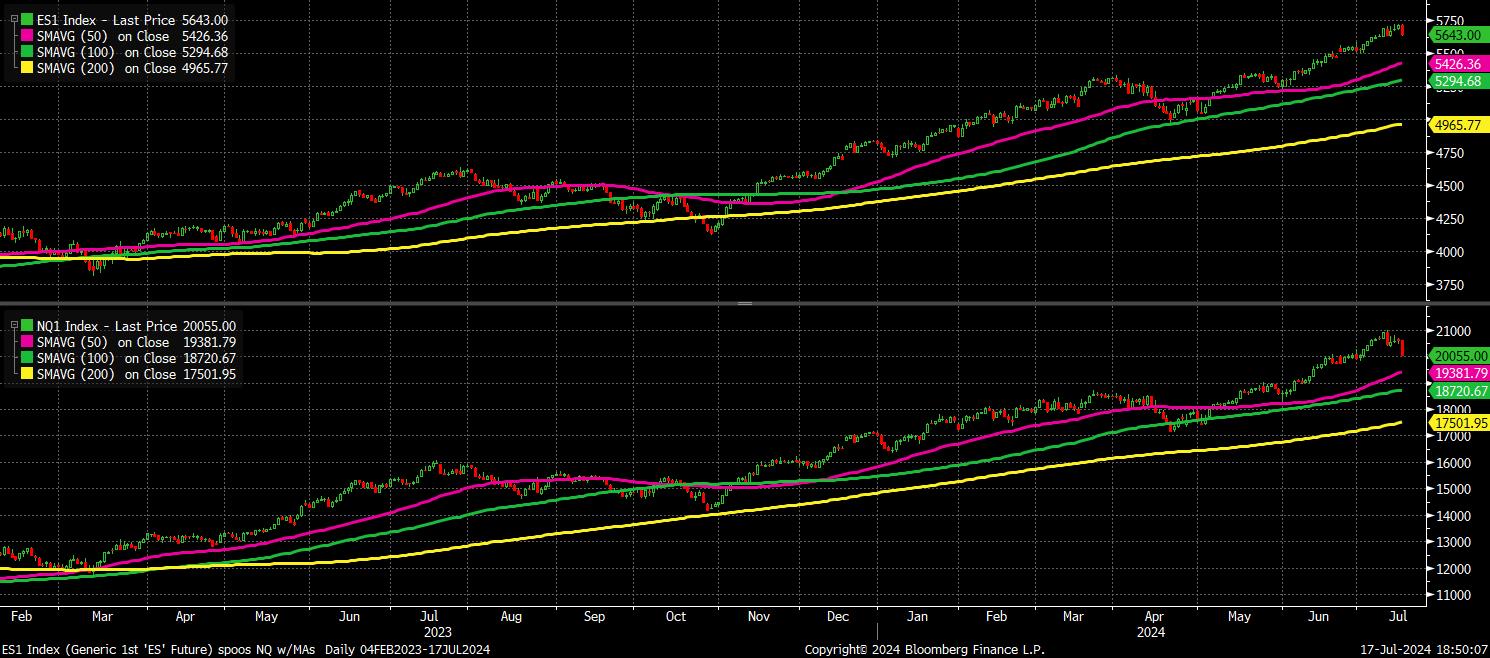Analysis
Just as everyone was getting all over-excitable about the so-called ‘Trump Trade’, said view appears to have been Trumped (pardon the pun) by reality, with stocks taking a battering during the midweek session.
At the time of writing, the front Nasdaq future trades as much as 2.5% lower, on track for its biggest one-day decline since December 2022, while the front S&P 500 future has slumped over 1%, in its biggest one-day decline since the end of April.

Naturally, this brings to mind a few questions. Namely – what’s causing the move? And, what might come next?
In terms of drivers behind the move, there appear to be a few:
- A continued rotation out of tech/growth stocks, and into value/small caps, which begun after last Thursday’s cooler than expected June CPI report cemented the case for a September Fed cut; the Russell marginally outperforming, down just 1% on the day, evidences this
- Something of a ‘sell winners’ vibe creeping into the market, as a number of momentum strategies appear to unwind, including a significant bout of JPY strength as some carry traders close out positions, and some profit taking being seen in gold after a run to fresh record highs during Tuesday’s session
- Soft guidance from chipmaker ASML, despite an earnings beat, exerting significant pressure on the sector, and European equities more broadly, with the name being the biggest stock by weight in both the AEX and the STOXX 50
- Sticking with chipmakers, reports that the Biden administration is seeking to impose tougher restrictions on the sale of chips to China, though this has provided a boost to some stocks in the sector such as Intel (INTC +2%)
- Finally, comments from President Trump in a wide-ranging Bloomberg interview that Taiwan has “stole” the US’ tech business, and should “pay” for the security guarantee that the US provides to the island
Taken together, that’s a rather potent mix of negative factors to hit the market at the same time. Add in the fact that we are in the middle of summer – with even the UK weather starting to warm up – meaning that this mix has hit the market at a time of thinner than usual liquidity, and light volumes, exacerbating the selling pressure.
As for what comes next, I see little reason to expect significant downside moves to continue, and stick to my long-standing view that dips remain buying opportunities.
Earnings season continues, with reports having proved solid enough so far, with around 80% of S&P 500 stocks having reported positive EPS surprises, even if guidance has been a touch soft in parts. Furthermore, economic growth remains resilient, with the control group retail sales measure – which feeds directly into the GDP release – having risen 0.9% MoM last month, its fastest pace since March, with the old adage of never betting against the US consumer continuing to ring true.
Of course, there is also the supportive policy backdrop to be considered. While markets price a September Fed cut as a near-certainty, the OIS curve implies a 96% chance of such a move, this is likely to be the start of a normalisation cycle, with quarterly cuts from there onwards remaining the base case. Nevertheless, with the battle against inflation seemingly won, the flexible and forceful ‘Fed put’ remains in place, with policymakers willing, and able, to cut more aggressively, and inject targeted liquidity, were it to be required.
Investors remain safe in the knowledge of this concept, hence are likely to remain comfortable to stay further out the risk curve. In fact, policymakers have already given us a glimpse of this ability, having slowed the pace of quantitative tightening by more than expected at the May FOMC, in order to prevent funding issues from occurring, and thus ensuring a greater provision of liquidity.
In short, with growth resilient, and looser policy on its way, the path of least resistance should, over the medium-term, continue to lead higher on Wall Street. A pullback is, of course, healthy, helping to remove some froth from the market, though dips are likely to remain well-bought.
The material provided here has not been prepared in accordance with legal requirements designed to promote the independence of investment research and as such is considered to be a marketing communication. Whilst it is not subject to any prohibition on dealing ahead of the dissemination of investment research we will not seek to take any advantage before providing it to our clients.
Pepperstone doesn’t represent that the material provided here is accurate, current or complete, and therefore shouldn’t be relied upon as such. The information, whether from a third party or not, isn’t to be considered as a recommendation; or an offer to buy or sell; or the solicitation of an offer to buy or sell any security, financial product or instrument; or to participate in any particular trading strategy. It does not take into account readers’ financial situation or investment objectives. We advise any readers of this content to seek their own advice. Without the approval of Pepperstone, reproduction or redistribution of this information isn’t permitted.
